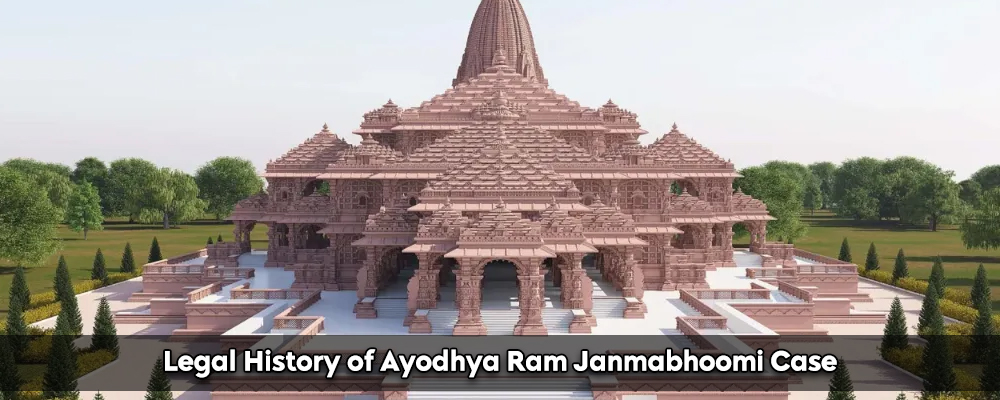The Supreme Court of India resolved one of the longest-running civil cases in Indian courts on November 9, 2019. The parties who had contested the construction of a Ram temple won the case. For ease of reference, they are called Hindu parties. Ayodhya’s Muslim community and the Sunni Central Waqf Board filed Suit No. 4 in an attempt to establish that “the entire disputed site of the Babri Masjid was a public mosque.” For ease of use, they are called Muslim parties.
The Allahabad High Court granted a one-third share to each of the three parties—Hindus, Muslims, and Nirmohi Akhara—as joint titleholders of the property.
The Supreme Court altered the ruling of the High Court. It ruled that the plaintiff’s deities (Hindu parties) own the disputed site, and it forbade the defendants from interfering with or impeding the building of the new temple.
Need A Legal Advice
The internet is not a lawyer and neither are you. Talk to a real lawyer about your legal issue

Legal history
- The legal battle started in 1885 when Mahanth Raghubar Das filed a suit in the Faizabad civil court against the Secretary of State for India in Council under suit number 61/280. Das argued in his lawsuit that he should be allowed to build a temple at the location of the chabutra in the outer courtyard because he was a mahanth. The lawsuit was dropped.
- A Civil Appeal (No. 27) was filed in 1886 in opposition to the 1885 ruling. Before issuing the order, FER Chamier, the district judge of Faizabad, decided to visit the location. Later, he rejected the appeal.
- A second Civil Appeal (No. 122) was submitted in opposition to this decision, but the Judicial Commissioner’s court dismissed it as well.
- Ayodhya witnessed a riot in 1934 during which Hindus destroyed a section of the disputed site’s structure. The British had rebuilt that portion.
- Gopal Singh Visharad of the Hindu Maha Sabha was the first party to file a lawsuit in the case in independent India on January 16, 1950. Gopal Visharad filed a lawsuit to have the right to pray and perform pooja in the inner courtyard, against five Muslims, the state government, and the district magistrate of Faizabad. The civil judge approved the puja and issued an injunction on the same day.
- Pramahans Ramchandra Das filed a second lawsuit on May 25 against Zahoor Ahmad and others. This lawsuit was identical to the first one. On December 17, 1959, nine years later, Nirmohi Akhada filed the third lawsuit to unseat the receiver and assume management.
- Two years later, on December 18, 1961, the Sunni Central Waqf Board filed a fourth suit in the civil judge’s court in Faizabad, along with all the defendants listed in the previous suits, pleading for the removal of idols and the transfer of mosque ownership. The court ruled on March 20, 1963, that a small number of people could not represent the entire Hindu community.
- Former Allahabad High Court Judge Deoki Nandan Agarwal filed a fifth lawsuit before the civil judge in Faizabad on July 1, 1989, referring to Ram Lala Virajman as his “next friend” (the deity being considered a minor legal person). It prayed that Ram Lala be given the entire location so that a new temple could be built there. Shia Waqf Board also filed a lawsuit and entered the case as a defendant in 1989.
- Hari Shankar Jain submitted a petition to the Allahabad High Court’s Lucknow bench on December 21, 1992, claiming that worshipping Lord Ram was his inalienable right. Every Hindu has the right to worship at the location thought to be Lord Ram’s birthplace, according to a ruling made by the high court on January 1, 1993.
- The Ayodhya dispute’s title suit was put on hold thirteen years after the Allahabad High Court took up the case in March 2002. The Allahabad High Court commanded excavation at the contentious location in July 2003. The excavation was carried out by the Archaeological Survey of India (ASI), which turned in its report on August 22, 2003. According to ASI’s report, there were Hindu pilgrimage artifacts and a sizable structure underneath the contested structure.
- The Allahabad High Court’s three-judge panel, consisting of Justice Dharamveer Sharma, Justice Sudhir Agarwal, and Justice SU Khan, rendered its decision in the title suit on September 30, 2010. It gave one portion of the disputed land to the Sunni Waqf Board, Nirmohi Akhada, and Ram Lala.
After this, a five-judge bench was appointed by the SC to hear the Ayodhya title suit.
Lead India provides various legal services, including free legal advice and internet information. You can talk to a lawyer and ask legal questions about the law here.





 Talk to a Lawyer
Talk to a Lawyer